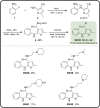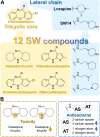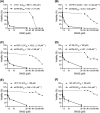Discovery of new dibenzodiazepine derivatives as antibacterials against intracellular bacteria
- PMID: 38283231
- PMCID: PMC10809566
- DOI: 10.1039/d3md00418j
Discovery of new dibenzodiazepine derivatives as antibacterials against intracellular bacteria
Abstract
The emergence and spread of multidrug-resistant bacteria underscore the critical need for novel antibacterial interventions. In our screening of 12 synthesized thienobenzodiazepines, pyridobenzodiazepines, and dibenzodiazepines, we successfully identified a small molecule compound SW33. Notably, SW33 demonstrated potent inhibitory activity against intracellular multidrug-resistant and fluoroquinolone-resistant strains of S. typhimurium in both macrophages and epithelial cells. Furthermore, SW33 was also effective against intramacrophagic Salmonella typhi, Yersinia enterocolitica, and Listeria monocytogenes. These significant findings suggest that SW33 possesses broad-spectrum activity against intracellular bacteria.
This journal is © The Royal Society of Chemistry.
Conflict of interest statement
There are no conflicts to declare.
Figures







References
-
- CDC, National Enteric Disease Surveillance: Salmonella Annual Report, 2016, 2018
LinkOut - more resources
Full Text Sources

